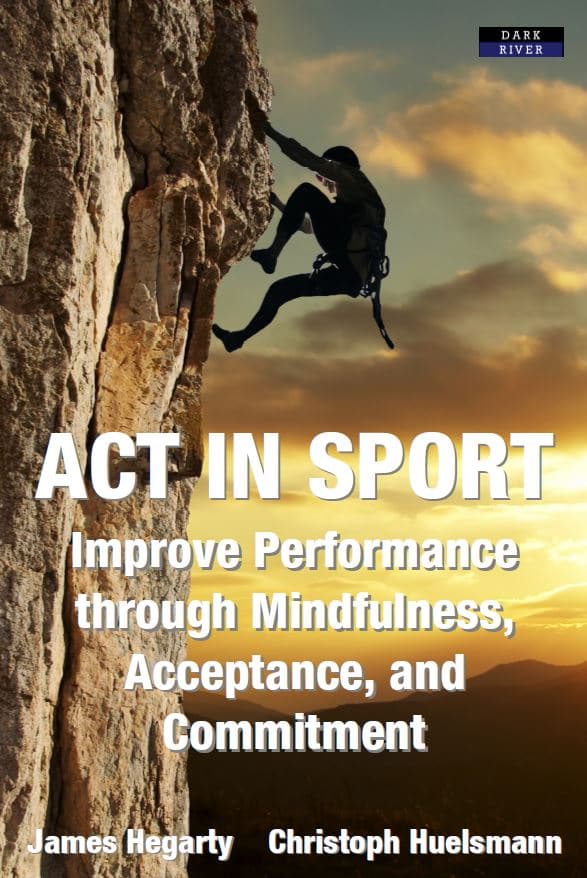An excerpt from the practical, new book on ACT in Sport
[click the cover to learn more]
*
What is ACT?
If you are ‘doing ACT’, it will look and often feel very different to other psychological approaches.
Instead of trying to control your thoughts, ACT will suggest you don’t. Instead of trying to get rid of unwanted and unpleasant emotions, ACT will say ‘pay attention’ to them. Instead of trying to fix your negative thinking, ACT will say it is fine, just leave it alone. Why? Why is the ACT approach so awkward? Well, really, it isn’t. In fact, most people say that once they get the hang of it, ACT feels natural to them. It fits with their experience of what life is like. And it gets results.
So, what is ACT?
ACT is the practical application of the Psychological Flexibility Model. That model says that humans tend to respond to situations in a limited set of ways. We have developed certain patterns of thinking, and sets of standard emotional and behavioural reactions, to most types of situation. This is based on what has worked for us in the past.
The trouble is, the present and the future are not always the same as the past, and we need to be free to respond to changing situations. Part of the reason for this, is that our old patterns of thinking and reacting (both emotionally and behaviourally) can get in the way of effective action. Basically, we tend to be fairly fixed and rigid in our reactions.
A simple example of this would be when you put money in a food or drink vending machine, make your choice, and nothing comes out of the slot.
What do you do?
Most people push the button again. And again. And again.
Sometimes this works, but most of the time, we keep pushing the button long after it is clear we aren’t going to get anything. Einstein called this the definition of insanity: doing the same thing over and over and expecting a different result. The behaviour is rigid, and not productive. Developing psychological flexibility means that we can be more creative and responsive to situations that arise.
Emotional reactions can be even more limiting. Imagine our sportsman Wayne, getting feedback from a coach on how to improve a technique. He is very sensitive to criticism. His automatic feeling is that the coach is criticising him. A strong emotional reaction to criticism can lead to old patterns of thinking like: ‘They are saying I am rubbish’; ‘Everyone will think I am useless’; ‘I will get kicked off the team’.
Or, Wayne could react to these emotions by thinking that the coach doesn’t know what he is talking about. He might start thinking negative things about his coach, and how he will prove him wrong. In both instances, the player’s attention is not fully on the feedback, so he will have missed something that could be helpful to him. Wayne’s habitual patterns of thinking and feeling got in the way!
If we are psychologically flexible, we can learn to have these reactions, and still attend to what is happening in the moment. That frees us up to respond on the basis of what is needed, rather than on old emotionally-driven patterns. This suggests that the most effective people are flexible in their response to changing circumstances.
Concisely, the aim of ACT is to help us to become more flexible, accurate, and effective in responding to the situations and the challenges we meet. It is based on an underlying philosophy that puts function – what works – over our ideas and expectations. In psychological terms, that simply means that it puts outcomes over other ‘theoretical’ considerations such as how we expect things should be, or what we consider to be right or wrong.
ACT also encourages the monitoring of behaviour to see if there is change. With this very functional approach, ACT has identified three broad areas that lead to greater psychological flexibility and effective action. These processes can be summarised roughly as:
1. Openness – being open and fully engaged with your own private experiences (feelings, bodily sensations, thoughts)
2. Awareness – being aware of the present moment (what is happening now, including what is happening around you), which opens up the opportunity for…
3. Engagement – fully committed, effective action, which is based on being fully aware of your personal values (what is important to you)
A strong focus on ‘what is fundamentally important to you’ is one thing that sets ACT apart from other models of behaviour change. It puts an emphasis on the bigger picture in a way that is relevant to you, the individual, or the team. It puts an emphasis on what works in relation to those things that make what you do worthwhile. Not simply by paying lip service to them, but in a practical, day-to-day manner that relates to what you actually do.
We will describe this in a little more detail shortly, and devote a whole chapter to working with what ACT calls ‘Values’. Before we give you a more detailed description of ACT, where it came from, and how it might look in practice, it might be a good idea to first look at what ACT is not. It can be useful to keep this in mind as we work through the exercises in this book.
What ACT isn’t
ACT is not a set of techniques.
It is a way of looking at the common basic functions of language and emotion that impede our performance, and provides ways to work with these processes to improve performance.
ACT naturally uses various techniques and strategies, but these are aimed at specific psychological and behavioural processes. We outline these, and how to work with them, in the following chapters. You will be given quite a few strategies and techniques to use. Don’t get hung up on individual techniques. Focus on the processes you are working on.
ACT does not supply a recipe book, or cookie-cutter approach. You can use ACT in such a manner – such as designing a set course of interventions for groups – but being aware of the main areas that ACT addresses opens up the possibility of multiple ways of working with the fundamental building blocks of performance (rather than being constrained to a limited range of techniques).
What ACT Is
ACT is a modern form of performance enhancement that developed out of the scientist-practitioner tradition. That means, it is based on science; an understanding of the science of how people work, their feelings, their thinking, and their behaviour. This knowledge is then devoted to practical applications.
ACT is used in a wide variety of settings with the common feature being the development of psychological flexibility as an aid in producing more effective behaviour. While we will talk a lot about emotions, and thoughts, ACT is all about making our behaviour more efficient.
There are a lot of different types of psychology which emphasise slightly different things, or ways of dealing with issues. Often these approaches will emphasise different techniques. The reality is that there are far fewer underlying psychological mechanisms of change, or performance enhancement, than there are techniques or models of change.
If you can identify the psychological mechanisms or areas that are relevant to your situation, you can target them more effectively. That is what we hope to teach you in this book.
*


